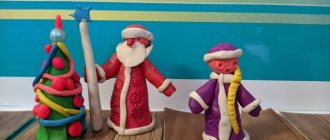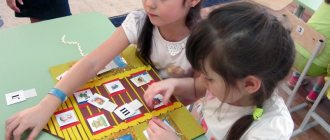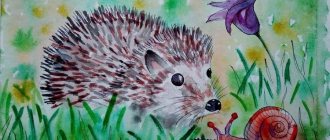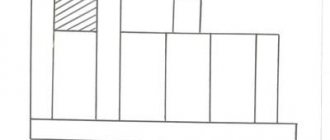Developmental manual “Playing the fairy tale “Teremok”
Author's educational manual “Playing the fairy tale “Teremok””
The purpose of creating a game-aid is to maximize the development of children’s speech using familiar characters from a fairy tale, increasing children’s vocabulary, mathematical understanding of counting and ordinal numbers, enriching them with new knowledge about animals, improving the ability to construct a sentence, developing imagination and fantasy, as well as careful attitude towards all living things.
Description of the manual:
The game consists of six cubes of various sizes - from small to large, in accordance with the sizes of the heroes of the fairy tale "Teremok":
The Mouse is the smallest cube, the Frog is a little larger, the Bunny is even larger, and so on, the Fox, the Wolf, and the largest cube is the Bear.
Each cube is a specific color.
On one of the faces of each cube is an image of a fairy tale hero.
On the other side there is an image of numbers in accordance with who first came to the mansion and settled in it: Mouse - 1, Frog - 2, Bunny - 3, Fox - 4, Wolf - 5, Bear - 6.
Another face is a visual representation of these numbers in the form of circles: 1 is *, 2 is **, 3 is ***, etc.
On the next side there is an image of what this animal eats: Mouse - cheese, Frog - flies, Bunny - carrots, Fox - cockerel, Wolf - sheep, Bear - honey.
The next facet tells about the animal’s habitat: Mouse in the field and in the forest, Frog - on a bolt and by the river, Bunny - in the forest, Fox - in the forest, Wolf - in the forest, Bear - in the forest.
Another facet represents the artist’s mistakes when he drew these animals: the Mouse has a rabbit’s tail, the Frog has hare’s ears, the bunny has a wolf’s tail, the Fox has bear’s ears, the Wolf has a mouse’s tail, the Bear has a fox’s tail.
Another feature of the cubes is their internal filling with a material that makes sounds differently, in accordance with how each of the animals moves or gives a voice: in the cube with the Mouse the filler is cotton wool, in the cube with the Frog - beer tin lids, in in the cube with the Chanterelle - foam rubber, in the cube with the wolf - dry twigs, in the cube with the Bear - nut shells.
The second part of the manual consists of dolls for the puppet theater, made with terry socks of various colors in accordance with the color of the animal characters in the fairy tale, thereby making them easier to make and use by children.
There are several options and possibilities in the game with this manual. With its help you can:
just tell the fairy tale “Teremok” and build a tower from cubes,
count the heroes of the fairy tale and visually determine the corresponding number and ordinal number of the animal,
name what this animal preferably eats and add other food preferences,
determine the habitat and compare where such animals most often live,
find the artist's mistake,
“listen” using the cube filler and imagine how these animals move or voice,
use your imagination and come up with a new fairy tale,
using fairy tale characters for the puppet theater to tell and show the fairy tale.
Teremok. Mathematics with the fairy tale "Teremok".
Description:
METHODOLOGICAL INSTRUCTIONS FOR WORKING WITH THE PROJECT
Mathematics with the fairy tale "Teremok".
The author of the project is Elena Valentinovna Zykova, teacher at GBDOU kindergarten No. 14 in the Nevsky district of St. Petersburg.
The project was created using Mimio Studio interactive technologies and contains 22 pages.
Project goal : Preparation for mastering basic mathematical skills, development of logical thinking, attention, speech and memory.
The project is advisory in nature and is designed to work with children of middle preschool age.
Each item is equipped with a hyperlink that allows you to navigate by name to the required page. On each project page, the hyperlinks are yellow arrows that allow you to go to the next and previous pages, as well as a house in the upper right corner that allows you to return to the table of contents. The tasks on the pages can be found by clicking on the active link.
PAGE #1. Title page
PAGE #2. Table of contents.
Content
Guys! Today we have an unusual but familiar fairy tale. And you will find out which one after you solve the riddles.
PAGE #3. Solve riddles and learn fairy tales.
The teacher reads riddles. When guessing riddles, we check the correctness of the answer by clicking on the text of the fairy tale.
PAGE #4. Number the animals.
The task is aimed at the ability to use ordinal numbers. Number the animals in the order of their appearance in the fairy tale, assigning a corresponding number to each.
PAGE #5. Arrange the apples correctly.
There is a tower in a field. A mouse was running, saw a little house and wanted to enter, but the hedgehogs blocked its path. They want the mouse to arrange the apples correctly. Help the mouse.
Task: using the clone function, arrange a given number of apples.
PAGE #6. Arrange the pictures correctly.
A mouse lives in a little house. A frog jumped up and asked to go into the little house. And the mouse says: arrange the pictures correctly. Can you help the frog?
Spatial orientation task: arrange pictures by moving them in a given direction.
PAGE #7 . Place the pictures in their places.
A mouse lives with a frog. A bunny came running and asked to come into the little house. And the mouse and the frog offer him to put the pictures in their places. We need to help him.
Space orientation task. The teacher invites the children to arrange the pictures, moving them to given places, using prepositions.
PAGE #8. Enter a number corresponding to the number of items.
And now the three of them live together. The fox goes and asks to go to the little house, and the animals ask her: put the numbers corresponding to the number of objects.
Task: sum up the number to the corresponding number of objects.
PAGE #9. Make up the number 5.
There are four of them living together. A wolf runs past, sees a little house and asks to be let in, and the animals respond: make the number 5 from red and green apples.
Task: make the number 5 and show all the options using green and red apples.
Using the clone function, arrange a given number of apples.
PAGE #10. Place objects similar to them next to the figures.
Five of us began to live together. A bear walks by, and when he roars, let me into the little house. And the animals say: place objects similar to them next to the geometric figures.
Task: move objects similar to them to geometric shapes.
PAGE #11. Build a tower.
The bear didn't fit into the door. The bear climbed onto the roof and crushed the tower. Let's help the animals build a new house.
Assignment: build a tower from geometric shapes by moving the shapes.
PAGE #12. Arrange the animals by height.
Animals live in a new house and they wanted to find out: which of them is taller, which is shorter.
Task: arrange the animals by height: from left to right, starting with the tallest, moving the figures.
PAGE #13. Recognize animals by their voices.
Here they are, living happily in the little house, singing songs. Recognize animals by their voices.
The page is equipped with a sound effect; when you click on the player icon, the voices of animals are heard.
PAGE #14. Place the animals on the wheel.
The animals wanted to ride on a wheel. Help them get settled.
Spatial orientation task: move animals to a given place.
PAGE #15. Fill in the empty cells with the missing figures.
The animals live and play together in the little house. Play with them: fill in the empty cells with the missing figures.
Assignment: Children must arrange the figures so that there is only one of them in each row and each column.
PAGE #16. Correct the broken pattern.
Look at the row: squirrel, pine and fungus; squirrel, pine and fungus; squirrel, pine and bunny. What's wrong here?
The teacher invites the children to trace the pattern. If you answer correctly, click on the bunny - it will disappear and a squirrel will appear.
PAGE #17. Which mushroom is the odd one out?
Children, help the animals name the extra mushroom.
Assignment: “Which mushroom is the odd one out?” An extra fly agaric because it is inedible. By clicking on a fly agaric, a green check mark appears on it.
PAGE #18. Which tree is the odd one out?
Which tree is the odd one out?
Task: “Which tree is the odd one out?” There is an extra pine because it is a coniferous tree, and the rest are deciduous. By clicking on a pine tree, a green check mark appears on the pine tree.
PAGE #19. Play hide and seek with the animals.
Children, the animals want to play hide and seek with you.
Assignment: invite children to find hidden animals by pulling them out from behind a tower, birch, pine, oak, flowers and a mushroom. When you spot animals, pronounce their location.
PAGE #20. Place vegetables for the bunny.
The bunny goes for vegetables. Give them to him.
Assignment: Arrange vegetables according to instructions.
PAGE #21. Seasons.
Children and animals are thinking, what time of year is it now?
Assignment: Carefully look at the “Seasons” pictures with the children. When answering a question, you need to select a suitable picture and click on it.
PAGE #22. Thank you!





